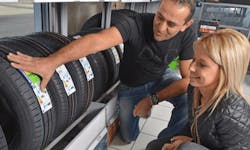It has now been seven years since the latest changes in European tire label legislation came into effect. This past December, the European Parliament and the Council of the European Union decided to confirm the next stage of the label’s progressive development, which will be introduced in May 2021. At the same time, conditions of the labeling agreement require a further review of regulations by June 2025.
I have looked into this latest development, which effectively reduces the tire label grades to just the A, B, C, D and E categories and eliminates the current lower grades of F and G.
Upon closer inspection, it is interesting to note that the revised E category is the same as the previous F category and the D rating equates to a zero grade on the current passenger car label.
In my opinion, this change is just a redistribution of the previous grades.
The latest rules of the advanced tire label rating system also include reinforced market surveillance and penalties that are designed to improve compliance and stronger enforcement of a tire registration. I have also heard that there is a future possibility that incentives to buy A-rated tires will be introduced.
In addition, there will be an obligation to report label information to national authorities in order to create improved product visibility to customers.
And the design of the European tire label is also going to change with the new version being re-tooled along the lines of the current European energy label.
At the top of the label there will be an additional, built-in QR code. Rolling resistance/fuel consumption and wet grip performance information will remain on the main part of the label, but with redesigned icons.
The pass-by noise section of the label has been redesigned in order to represent the sound level with a letter rating. But the decibel value remains the same.
At the same time, the ice grip identifier area has also undergone a design change. Finally, a new graphic logo has been added to represent results of the forthcoming abrasion test.
As we start a new year, it will be interesting to see how tire market players throughout Europe react to the changes, which, in my opinion, can only further enhance the safety level of new tires.
I have spoken with a number of people in the industry, including manufacturers, distributors and retail tire stores.
Everyone with whom I have talked agrees that the design changes are justified and the new rating scores have been well-received.
Looking at this new development from a manufacturing point of view, I believe it puts even more pressure on the leading brands to make their tires increasingly efficient.
Tire distributors also could start to look even more carefully at which tires they want to distribute and retail tire stores will be armed with even more tire safety information when trying to sell a particular brand.
But how does the tire buyer feel? There is still a misguided belief that you should pay as little as possible for new tires, especially among drivers who own older cars.
However, I have noticed a more encouraging attitude from owners of new vehicles who want their shiny cars to look attractive and sporty.
These consumers are more likely to invest in a more expensive major brand, with many safety aspects as possible. At the end of the day, the impact of labels on tire sales remains to be seen. ■
John Stone has been working within the global tire industry for the past 29 years. In 2004 he launched his own consulting company, Sapphire Media Service, which caters to business media clients around the globe. Stone also writes for tire and automotive-related publications in Europe, South Africa and Asia.
About the Author
John Stone
John Stone has been working within the global tire industry for more than 30 years and is the owner of Sapphire Media Service, which caters to business media clients around the globe.
